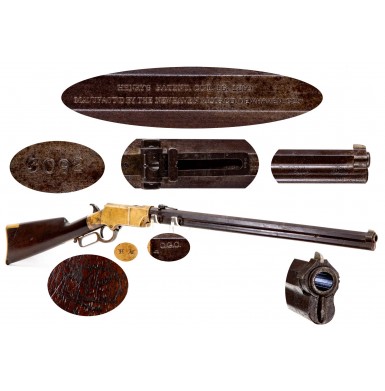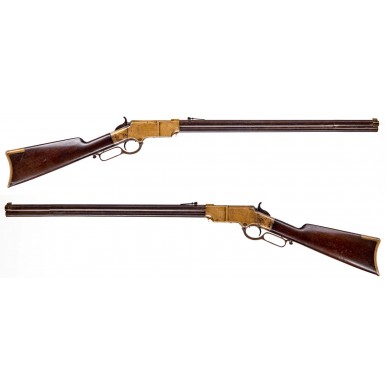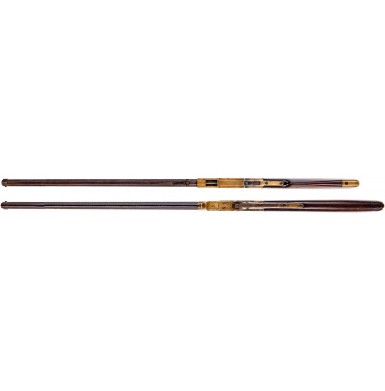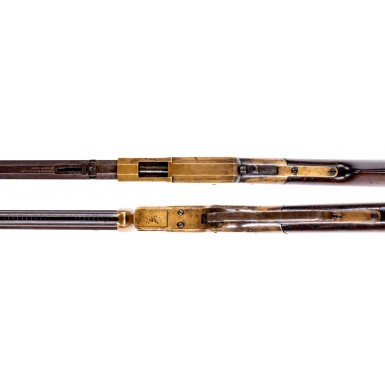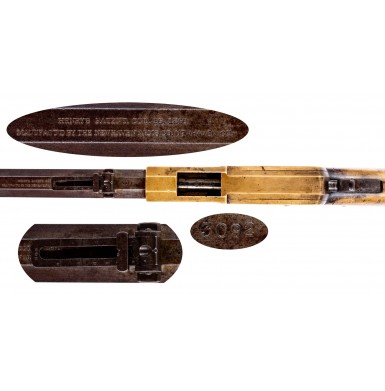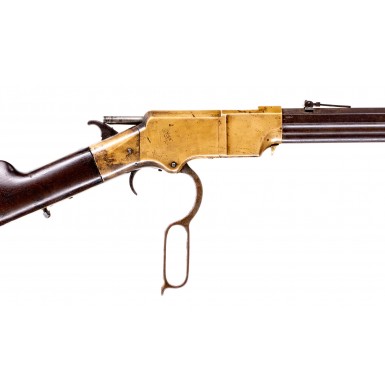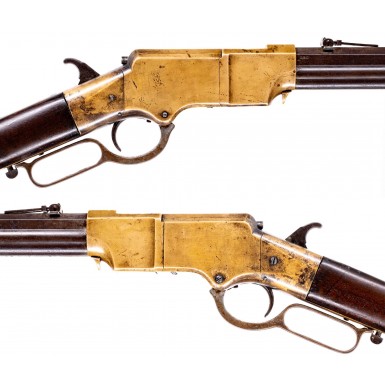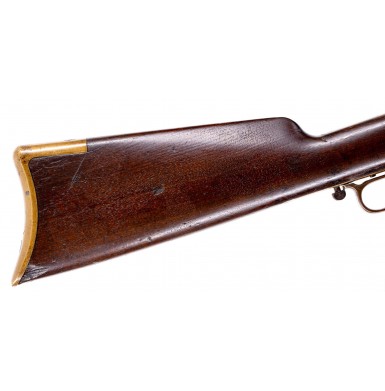It is often said that success is born from failure and that adversity breeds success. Assuming that both of these axioms are true it is no surprise that Oliver Winchester and his Winchester Arms Company were eventually incredibly successful in the manufacture and sale of firearms. However, as the Civil War was looming into view in the spring of 1861, Winchester must have had a rather pessimistic outlook for the future.
In 1855, Winchester had invested the newly established Volcanic Repeating Arms company, which had been founded by Horace Smith and Daniel Wesson – later to be very successful as the famous revolver manufacturers Smith & Wesson. However, in 1855 the firm was concentrating on the manufacture of an improved lever action repeating pistol and rifle based upon the Hunt-Jennings design, utilizing the self-contained “rocket ball” ammunition. In 1856, both Smith & Wesson left the firm and the company moved to New Haven, CT. But the arms, known as “Volcanics”, were not a commercial success and the firm found itself in receivership soon after the move. Winchester, who had made a small fortune as a ready-made clothing manufacturer, understood the concepts of factory production and marketing, if not the finer points of firearms design, acquired the assets of the failed company and reorganized it as the New Haven Arms Company. The new company continued to manufacture “Volcanic” arms and raised capital by offering shares of stock for sale. While two of the most brilliant minds in 19th American firearms design had left the company when Smith & Wesson abandoned the Volcanic project, they left behind their foreman B. Tyler Henry. Henry was an energetic and forward thinking machinist and inventor who was already looking past the Volcanic to a new, improved firearm. Henry understood that one of the greatest shortcomings of the Volcanic line was the anemic and unreliable “rocket ball” ammunition. To that end, he had been working on the development of a rimfire ignition, self-contained metallic cartridge in .44 caliber. The end result, after developing a reliable cartridge and after making some mechanical improvements to the Volcanic design resulted in the famous lever action repeating rifle known simply as the Henry Rifle.
On October 16, 1860 Benjamin Tyler Henry received US Patent #30,446 for his new rifle, and as they say, “the rest is history”, but it almost wasn’t. After years of limited success with the Volcanic series of arms, the company found itself in dire financial straits. After early setbacks and complaints regarding Volcanic Arms, the company realized that the firearms would probably never be a viable product. However, as great expenditures had been made in the acquisition of the specialized machinery, jigs and dies to manufacture the arms, as well as the necessary materials and subcontracted parts to produce them, Winchester felt the only opportunity to recoup any of the company’s capital investment was to complete the arms they had originally intended to produce, and sell them, even if that meant taking a loss. In the meantime, knowing that Henry’s design was a significant improvement and was a real, viable product, the firm had to raise cash to obtain the necessary machinery, jigs and fixtures to produce the new rifle. To that end, Winchester accepted a contract to manufacture 3,000 of the ten-shot, .31 caliber Walch Patent Pocket Revolvers, in an attempt to raise capital for the company and create some cash flow. However, the Walch contract was subsequently broken and the revolvers that were produced were tied up in legal wrangling until the summer of 1863, meaning that for the time being Winchester and his partners were out even more money and no closer to being able to manufacture what they knew was a good product.
The consistent problems with cash flow and luck meant that it would be the spring of 1861, at the very outbreak of the Civil War, before the company would start to acquire and fabricate the tooling and machinery needed to manufacture the Henry Rifle. The problems were so serious that the company was not producing Henry Rifles until the summer of 1862, and Winchester opined to an investor in an October of 1862 letter that “We have been on the market about three months…till within the last three months, five and a half years, there has not a been a month in which our expenditures have not exceeded our receipts. Consequently, we have accumulated a very large indebtedness ($77,437).” Depending on what comparisons you do for that amount of money then and now, the amount of the New Haven Arms Company debt in 1862 would be equivalent to more than $24,000,000 (yes, million) worth of debt today. To say that the situation was dire, would be an understatement. And yet Oliver Winchester saw light at the end of the tunnel, if only he could achieve commercial and military acceptance of the new product, all would be well as the world would come clamoring to his door to buy Henry Rifles. He was correct, but it would take another tremulous year before sales would pick up to the point that he could relax a little bit.
The rifle that B. Tyler Henry had designed was a lever action repeater with a 24” octagonal barrel with a tubular magazine under it. The magazine held fifteen cartridges and with a sixteenth round in the chamber, that many successive shots were available without reloading. The simple toggle action lowered a cartridge lifter to the rear of the magazine tube when the lever was pushed down ad forward. The magazine spring then pushed a cartridge onto the lifter. Lowering the lever also opened the bolt of the rifle and extracted the spent round from the chamber. As the bolt slid back out of the frame, it pushed the hammer spur backwards, cocking the hammer. When the lever was closed, the fresh cartridge was elevated to the chamber mouth, at which point the bolt slid closed, forcing the cartridge into the chamber. The rifle was then loaded and cocked and ready to fire.
While the majority of Henry rifles were produced with brass frames, about two hundred of the earliest guns were manufactured with iron frames. The highest reported example of an iron framed gun is serial number 355. The brass framed guns were mounted with brass buttplates and the iron frame ones with iron buttplates. A trapdoor in the buttplate concealed a recess for a multi-part cleaning rod. Two styles of stocks were manufactured for the Henry, the early production guns had a distinctly rounded shape to the toe of the buttstock while later guns have a distinctly sharper toe. This change occurred in the 4,XXX serial number range. At about the same time, around serial number 3,XXX the extra rear sight slot that had been machined in the frame of the rifle was eliminated, leaving only the slot on the barrel for the rear sight. The early guns had the option of the rear sight being mounted in either dovetail. The standard rifle retailed for $42.00 with sling swivels being an additional $2. For an additional charge the rifles were available engraved & silver plated for an extra $10 or engraved & gold plated for an extra $13. A leather case retailed for $5 and 1,000 of the .44 Henry Rimfire cartridges cost $17.50, or just under $.02 each.
While the Henry was certainly the most technologically advanced repeating rifle being produced in America at the time, it also had some issues that hindered its rapid acceptance in the marketplace, and these became ever more apparent when the guns finally entered military service. Like the its predecessor the Rocket Ball firing Volcanic, the Henry rifle’s cartridge was underpowered for a military firearm. The rimfire case contained 25-grains of black powder and fired a 216-grain bullet at about 1,100 fps, creating a muzzle energy of around 550 ft/lbs. This is about the same muzzle energy as the later Winchester .44-40 (.44 WCF) or the modern .44 Special cartridges, both of which, for all practical purposes are relatively mild rounds that are equally at home in a handgun. By comparison, the primary competitor to the Henry, the Spencer repeating rife fired a .55 caliber bullet that weighed about 350-grains at about 1,200 ft/s, resulting in more than double the muzzle energy at about 1,100 ft/lbs; a much more effective combat cartridge. The open magazine bottom under the barrel could easily become fouled, and the shooter had to relocate their support hand as they fired the rifle to prevent the follower in the magazine tube from being obstructed, which could cause a round to only partially feed onto the lifter and potentially jam the rifle. The barrel also became hot with repeated firing, and with no wooden forend to hold, the rifle could quickly become too hot to hold without gloves. The firing pins were fragile, and dry firing the rifle could result in their breakage, rendering the gun useless. To be fair to Henry’s design, even modern rimfire guns should not be dry fired, less the firing pin be broken on the chamber lip. The other problem was also related to the magazine. If the follower was released from its fully compressed position in an empty magazine without easing it down the tube, it could damage the frame where cartridges fed into the action from the magazine and cause the cartridges to hang up and fail to feed. This would lead to more failures in the field. Winchester rightly noted that most of the issues were due to mishandling of the firearm and abusive actions, but he and others with the company noted the issues so that they could be resolved in future versions of the gun. In the meantime, Winchester’s goal was to get the rifles into the market and land a lucrative military contract.
Winchester was so focused on obtaining a military contract that he submitted a handmade example of the Henry rifle for evaluation a year before the guns were actually in production. With the clamor to purchase small arms after the outbreak of the Civil War, Winchester was certain after the June of 1861 testing of the rifle that orders would be forthcoming, but they were not. General Ripley, head of the Ordnance Department was loathe to put repeating arms of any form into the field, let along those that relied upon new-fangled proprietary metallic ammunition that could not easily be manufactured in government arsenals. Like much of the old guard senior officers in Washington staff positions, the muzzle loading, single shot musket (or rifle musket) was considered the best weapon for infantry, and breechloaders were only for the use of cavalry, and then only as single shot, percussion weapons. In their opinions, fast firing repeaters just meant the soldiers would waste ammunition, and special metallic cartridges would only be expensive and difficult to supply in the field. Despite the firm rebuff that Winchester received from Ripley, he continued to lobby the Secretary of War and continued to promote the Henry within the civilian market as well as for private sale to Yankee soldiers.
In an interesting turn of events, when the Confederate Army of Braxton Bragg invaded Kentucky in the fall of 1862, it caused so much panic in Louisville that the local New Haven Arms agent there started selling Henry’s below cost as quickly as possible for fear the Confederates would capture them. In the process a number of these guns ended up being purchased by southern sympathizers, and a number of low numbered Henry rifles ended up in the hands of Woodard’s 1stKentucky Cavalry CSA as well as the 5th Kentucky Cavalry CSA! However, the inherent merits of the design and the firepower a single Henry rifle offered were not lost on more forward thinking military men. The famous 66th Illinois, which had evolved from the 14th Missouri “Western Sharp Shooters” acquired a large number of Henry rifles at their own expense, much like Colonel Wilder’s men purchased their own Spencer rifles, and both regiments put their new-found firepower to work quite effectively as mounted infantry. A fairly large number of Henry rifles were acquired privately or by states to arm parts, or even entire companies of regiments, and by the end of 1863, Henry rifles were in the field with 7th, 36th, 51st, 64th , 66th, 73rd, 83rd & 96th Illinois volunteer infantry, as well as the 12th Kentucky Cavalry (US), the 40th, 57th, 58th, 65th, & 97th Indiana volunteer infantry as well as the 40th Ohio volunteer infantry, just to name a few.
By the middle of 1863, the War Department and Ordnance Department were feeling the public pressure to equip cavalry regiments with the Henry rifle. A newly organized cavalry battalion known initially as Baker’s Mounted Rangers, but subsequently designated as the 1st DC Cavalry, would be the first to receive US Ordnance Department contract Henry Rifles. The unit was formed to directly counter the Confederate partisan rangers harassing norther Virginia and the Washington D.C. area, particularly John S. Mosby’s rangers. In order to give Colonel Lafayette Baker’s men, the greatest advantage they were to be armed with the Henry Rifle. To this end, two hundred and forty rifles were ordered in June of 1863 to arm his initial command of a battalion sized force, which eventually grew to be a full sized regiment. In the end some eleven hundred Henry rifles would be delivered under government contract for Baker’s command. The first three hundred came mostly from various New Haven Arms distributors and dealers, due to so few arms being available and on hand at the factory. These arrived in several shipments between June and October of 1863 and are not marked with US inspector marks. Their martial status is confirmed by their notation by serial number in the rolls of the 3rd US Veteran Volunteer Regiment, who received many of the former 1st DC Cavalry guns after this new regiment was formed in the spring of 1865. These initial Henry deliveries appear sporadically in the 1,300 to 3,000 serial number range and as noted are not inspected. The next eight hundred Henry’s delivered to the 1st DC Cavalry were delivered during the first part of 1864 and are all contained within the 3,000 to 4,000 serial number range. These guns were inspected at the New Haven Arms factory by Charles G. Chapman, who began the inspection process in February of 1864. These guns bear Chapman’s block C.G.C. mark on the right side of the barrel at the frame juncture and on the right side of the stock in the form of a script cartouche. This completed the single largest US government order for Henry Rifles. Two additional orders of five hundred and one hundred twenty-seven rifles were placed in April and May of 1865, respectively, for issue to the 3rd Veteran Volunteers. However, at this point the war was over and these guns did not see Civil War combat service. These final deliveries were not inspected by Chapman but bear other inspector marks like AWM. A number of the men in the 1st DC Cavalry purchased their guns and took them home after the war (a total of sixty-five according to Wiley Sword’s research), and an even larger number of the guns were lost while fighting Confederate forces on the Virginia peninsula not long after the guns were issued to them! Another sixty-two went home with the men of the 1stMaine Cavalry, the regiment into which most of the 1st DC Cavalry was folded in August of 1864 when the regiment was dissolved. Sometime after the siege of Petersburg, most of the remaining 1st DC Cavalry Henry Rifle were returned to the Ordnance Department and subsequently re-issued to the 3rd Veteran Volunteers, who were allowed to keep the guns home as part of the bonus they were given as veteran soldiers for re-enlisting. As a result of the large majority of 1st DC Cavalry Henry Rifles having seen service with two different regiments and subsequently being allowed to go home with the soldiers, these guns saw a lot of use and are typically well worn when found today. Many veterans moved west after the war, where their Henry Rifles did yeoman’s service in helping to tame the American West. With slightly less than ten thousand Henry Rifles manufactured prior to the end of the American Civil War, the Chapman inspected arms of the 1stDC Cavalry only represent about 8% of total wartime production, and only about 6% of total Henry production, if you include the guns produced after the Civil War. With only eight hundred of the Chapman inspected guns ever delivered, these are very scarce in any condition and are among the most sought after of the Civil War Henry Rifles and certainly the most desirable variant of the martially inspected guns.
Offered here is a very scarce, US Martial Henry Rifle, one of the eight hundred inspected by Charles G. Chapman and subsequently issued to the 1st DC Cavalry. The gun shows moderate wear and clearly saw significant use. Despite the wear the gun remains in about NEAR VERY GOOD condition, with both the metal and the wood showing the expected wear of a military saddle gun. The rifle retains strong and clear marks in the metal, with a soft but visible cartouche on the obverse stock. Like most US Martial Henry Rifles, the gun shows significant wear and use, but appears to have escaped the usual period repairs and minor replacement parts. The top of the barrel is clearly marked in two lines, forward of the rear sight:
HENRY’S PATENT OCT. 16, 1860
MANUFACTURED BY THE NEW HAVEN ARMS CO. NEW HAVEN, CT.
The serial number 3092 is stamped clearly on the top of the barrel between the rear sight and the frame. This same serial number is present on the lower receiver tang (concealed by the buttstock) and inside the buttplate. The buttplate screws are numbered with the full serial number, 3092, as is the long, upper tang screw. Both the upper and lower tang wood screws are numbered with only the last two numbers, 92. The upper tang mortise cut of the buttstock is also numbered 3092, although this mark is a little weak. The correct Charles G. Chapman C.G.C. inspection is present on the right side of the barrel at the frame junction, and the sub-inspection letter H is found struck twice on the forward part of the obverse frame and on the obverse barrel behind the Chapman mark. The script CGC cartouche is visible on the obverse stock but is not fully legible. The barrel has a moderately oxidized and slightly mottled plum brown patina, with some scattered areas of darker surface oxidation as well as some patches of surface roughness. The coloration is actually quite attractive and is very pleasing. The barrel is partly smooth with some scattered light pitting and areas of surface roughness on the top and side. The magazine tube shows more moderate roughness along most of its length, along the edges the boarder the open portion of the magazine. The hammer and lever have a moderately oxidized bluish-gray patina with scattered flecks of oxidation and discoloration. The brass receiver has a rich golden butterscotch patina and is very pleasing as well. The receiver shows scattered areas and patches of darker discoloration that appear to be a combination of powder fouling and oxidized age darkening. The side plates show the expected dings and some minor marks at their edges from their removal during the period of use for cleaning the interior mechanism. Numerous minor surface scratches and scrapes are present on the brass frame, but under the patina, indicating any cleaning done was a very long time ago. The top frame tang is slightly bent, but after examination under magnification and good light does not appear to have been broken. Broken Henry tangs are relatively common for any gun that saw significant use. The bend has resulted in a very minor gap at the butt to frame junction. The buttplate has a golden butterscotch patina that matches the frame perfectly and the butt trap door opens, with a little effort. The original 900-yard rear sight is in place in the dovetail. The sight patina matches the barrel very well. The sight folds and raises into position easily and the elevator slides with only moderate effort. The original 2nd pattern front sight blade is in place with the correct flat rear edge. It appears that the original lever latch is present in the lower tang as well. As is typical of most US inspected, martial Henry Rifles, the gun is not equipped with sling swivels. This was an extra price the Ordnance Department was not willing to pay. The bore of the rifle is in VERY GOOD+ to NEAR FINE condition, especially for a Henry. It retains strong rifling and has a nice evenly oxidized patina with some very lightly scattered pitting along its length. The bore is dramatically better than most Henry Rifle bores encountered today. The rifle is in mechanically FINE condition and lever and cartridge lifter both operate smoothly, the hammer cocks as it should and correctly responds to the pull of the trigger. The original follower is in place in the magazine and the magazine spring can still be usually be compressed slowly without significant binding, allowing the muzzle portion to be swiveled open for loading. The follower sometimes sticks in the front of the brass frame, due to wear and dings and as is the case with most Henry’s that retain their original magazine spring, only very careful pushing of the follower tab allows the spring to fully compress without binding or locking up. The buttstock shows wear commensurate with the balance of the metal and shows moderate wear as well. The wood is solid and free of any breaks, structural cracks or repairs. There is an old small chip of wood missing out of the lower edge of the obverse toe of the stock. As noted, there is some very minor gapping at the frame to butt junction, which appears to be due to a minor bend in the upper tang. As is so often the case with Henry Rifles, the stock has been lightly sanded and while not really “refinished”, appears to have some old added oil in the wood. As would be expected, the stock shows a number of bumps, dings, scrapes, scratches and mars.
Overall this is an attractive, solid and very reasonably priced example of a scarce and desirable C.G.C. inspected 1st DC Cavalry Henry Rifle. There is no doubt that this gun surely saw the elephant and, despite the wear and use, lived to tell about it. As noted, most of the 1st DC Cavalry guns saw hard use and were subsequently reissued, only to go home with soldier carrying it as a Veteran Volunteer. Many other martial Henrys were lost in combat or captured by Confederates during the spring – summer campaigns of 1864. If this rifle could talk it would certainly have some interesting tails to tell. While the gun is far from perfect, it is a real, authentic and very scarce early US martial Henry, a rifle that usually is not found on the market in less than the upper $2X,XX or low $3X,XXX price range. This gun is very reasonably priced for what it is in terms of rarity and historic significance, and I think you would have to pay several thousand dollars more to find a nicer example. This is a good opportunity to obtain a scarce and desirable marital Henry Rifle that displays very well for a very reasonable price. For a collector who has always wanted one but felt that typical $30,000+ price point was just out of their purchasing range, here is your chance to get a rifle you never thought you could have. This is a very attractive US military inspected Henry that you will certainly be glad to add to your collection and display.
SOLD

